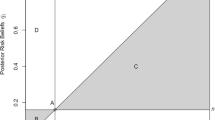Abstract
The food industry is highly competitive, and in order to survive, manufacturers must constantly innovate and match the ever changing tastes of consumers. A recent survey [1] found that 90% of the 13,000 new food products launched each year in the US fail within one year. Food companies are therefore changing the way new products are developed and launched, and this includes the use of intelligent computer systems. This paper provides an overview of one particular technique, namely Bayesian Belief networks, and its application to a typical food design problem. The characteristics of an “ideal” product are derived from a small data set.
Access this chapter
Tax calculation will be finalised at checkout
Purchases are for personal use only
Preview
Unable to display preview. Download preview PDF.
Similar content being viewed by others
References
AAFC 1991. “A Profile of the Canadian Speciality Food Industry” Market Report produced by the Canadian Department of Agriculture and Agri-Food.
Lauritzen, S L, Spiegelhalter, D J 1988. “Local computations with probabilities on graphical structures and their application to expert systems” Journal of the Royal Statistical Society, Vol. 50 No. 2 pp.157–224.
Pearl, J 1988. Probabilistic Reasoning in Intelligent Systems: networks of plausible inference Morgan Kaufmann.
Barnett, G O, Famiglietti, K T, Kim, R J, Hoffer, E P, Feldman, M J 1998. “DXplain on the Internet” in American Medical Informatics Association 1998 Annual Symposium
Helm, L 1996. “ Improbable Inspiration” Los Angeles Times, October 28, 1996.
Berler, A, Shimony, S E 1997. “Bayes Networks for Sonar Sensor Fusion” in Geiger, D, Shenoy, P(eds) 1997. Proceedings of the Thirteenth Conference on Uncertainty in Artificial Intelligence Morgan Kaufmann.
Neil, M, Littlewood, B, Fenton, N1996. “Applying Bayesian Belief Networks to Systems Dependability Assessment” in Proceedings of Safety Critical Systems Club Symposium, Leeds, 6–8February 1996 Springer-Verlag.
Frey, B J 1998. Graphical Models for Machine Learning and Digital Communication MIT Press.
Ezawa, K J, Schuermann, T 1995. “Fraud/Uncollectible Debt Detection Using a Bayesian Network Based Learning System: A Rare Binary Outcome with Mixed Data Structures”in Besnard, P, Hanks, S (eds) Proceedings of the Eleventh Conference on Uncertainty in Artificial Intelligence Morgan Kaufmann.
Roozenburg, N F M, Eekels, J1995. Product Design: Fundamentals and Methods Wiley.
Krause, P, Clark, D 1993. Representing Uncertain Knowledge: An Artificial Intelligence Approach, Intellect Books.
Jensen, FV 1996. An Introduction to Bayesian Networks UCL Press.
Heckerman, D 1995. “A Tutorial on Learning With Bayesian Networks”, Microsoft Research report MSR-TR-95–06..
Bishop, C M 1995 Neural Networks for Pattern Recognition Oxford University Press
Cooper, G F, Herskovits, E 1992. “A Bayesian Method for the Induction of Probabilistic Networks from Data” Machine LearningVol. 9 pp. 309 - 347.
Larranaga, P, Kuijpers, C M H, Murga, R H, Yurramendi, Y 1996. “Learning Bayesian network structures by searching for the best ordering with genetic algorithms” IEEE Trans on Systems, Man and Cybernetics-A Vol. 26 No. 4 pp.487–493
Etxeberria, R, Larranaga, P, and Pikaza, J M 1997. “Analysis of the behaviour of the genetic algorithms when searching Bayesian networks from data”, Pattern Recognition LettersVol. 18 No 11–13 pp 1269 - 1273
Narendra, P M, Fukunaga, K 1977. “A Branch and Bound Algorithm for Feature Subset Selection” IEEE Transactions on Computers, Vol. 26, No. 9, pp. 917 - 922.
Friedman, N 1998. “The Bayesian Structural EM Algorithm” in Cooper, GF, Moral, S (eds) Proceedings of the Fourteenth Conference on Uncertainty in Artificial Intelligence Morgan Kaufmann.
Dempster, A P, Laird, N M, Rubin, D B 1977. “Maximum Likelihood from Incomplete Data via the EM Algorithm with discussion”, Journal of the Royal Statistical Society, Series B, Vol. 39 pp.1–38.
Mitchell, T M 1997 Machine Learning McGraw-Hill
Author information
Authors and Affiliations
Editor information
Editors and Affiliations
Rights and permissions
Copyright information
© 2000 Springer-Verlag London
About this paper
Cite this paper
Corney, D. (2000). Designing Food with Bayesian Belief Networks. In: Parmee, I.C. (eds) Evolutionary Design and Manufacture. Springer, London. https://doi.org/10.1007/978-1-4471-0519-0_7
Download citation
DOI: https://doi.org/10.1007/978-1-4471-0519-0_7
Publisher Name: Springer, London
Print ISBN: 978-1-85233-300-3
Online ISBN: 978-1-4471-0519-0
eBook Packages: Springer Book Archive




